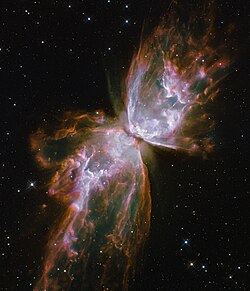Talk:NGC 6302
| This It is of interest to the following WikiProjects: | ||||||||||||||
| ||||||||||||||
Referencing the citations needed notations
[edit]I don't have access to the Nature article where it speculates the first discovery of extrasolar carbonates: "The detection of carbonates in NGC 6302 was made by Ciska Kempers, of the University of Amsterdam, and was published in 2002 in Nature, 415, 295." (nor am I willing to purchase access to the article to satisfy wikipedia's citation needed notations.
The findings and refutation are reported on here: http://www.astrobio.net/exclusive/290/looking-for-carbonates-in-dry-places —Preceding unsigned comment added by Pyrroc (talk • contribs) 02:32, 8 July 2010 (UTC)
File:NGC 6302 Hubble 2009.full.jpg to appear as POTD soon
[edit]Hello! This is a note to let the editors of this article know that File:NGC 6302 Hubble 2009.full.jpg will be appearing as picture of the day on February 22, 2011. You can view and edit the POTD blurb at Template:POTD/2011-02-22. If this article needs any attention or maintenance, it would be preferable if that could be done before its appearance on the Main Page so Wikipedia doesn't look bad. :) Thanks! howcheng {chat} 00:23, 18 February 2011 (UTC)
External links modified (January 2018)
[edit]Hello fellow Wikipedians,
I have just modified one external link on NGC 6302. Please take a moment to review my edit. If you have any questions, or need the bot to ignore the links, or the page altogether, please visit this simple FaQ for additional information. I made the following changes:
- Added archive https://web.archive.org/web/20110720152214/http://www.jodrellbank.manchester.ac.uk/news/2009/BugNebula/ to http://www.jodrellbank.manchester.ac.uk/news/2009/BugNebula/
When you have finished reviewing my changes, you may follow the instructions on the template below to fix any issues with the URLs.
This message was posted before February 2018. After February 2018, "External links modified" talk page sections are no longer generated or monitored by InternetArchiveBot. No special action is required regarding these talk page notices, other than regular verification using the archive tool instructions below. Editors have permission to delete these "External links modified" talk page sections if they want to de-clutter talk pages, but see the RfC before doing mass systematic removals. This message is updated dynamically through the template {{source check}} (last update: 5 June 2024).
- If you have discovered URLs which were erroneously considered dead by the bot, you can report them with this tool.
- If you found an error with any archives or the URLs themselves, you can fix them with this tool.
Cheers.—InternetArchiveBot (Report bug) 19:10, 20 January 2018 (UTC)
Spacetime anomaly?
[edit]Hello all concerned! Perhaps some clarification is required, or I'm just being stupid... if we have observed a 'prominent northwest lobe', how could it be calculated to have formed 'around 1,900 years ago' if its distance from us is 3400 ± 500 light years?
Kind regards Ianactually (talk) 21:59, 15 May 2024 (UTC)
- Start-Class level-5 vital articles
- Wikipedia level-5 vital articles in Physical sciences
- Start-Class vital articles in Physical sciences
- Start-Class Astronomy articles
- Mid-importance Astronomy articles
- Start-Class Astronomy articles of Mid-importance
- Start-Class Astronomical objects articles
- Pages within the scope of WikiProject Astronomical objects (WP Astronomy Banner)



